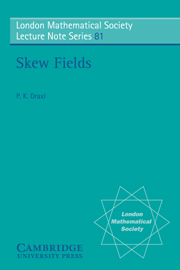Book contents
- Frontmatter
- Contents
- Preface
- Conventions on Terminology
- Part I Skew Fields and Simple Rings
- Part II Skew Fields and Brauer Groups
- Part III Reduced K1-Theory of Skew Fields
- 19 The Bruhat Normal Form
- 20 The Dieudonné Determinant
- 21 The Structure of SLn(D) for n ≥ 2
- 22 Reduced Norms and Traces
- 23 The Reduced Whitehead Group SK1(D) and Wang's Theorem
- 24 SK1(D) ≠ 1 for suitable D
- 25 Remarks on USK1 (D, I)
- Bibliography
- Thesaurus
- Index
24 - SK1(D) ≠ 1 for suitable D
Published online by Cambridge University Press: 04 August 2010
- Frontmatter
- Contents
- Preface
- Conventions on Terminology
- Part I Skew Fields and Simple Rings
- Part II Skew Fields and Brauer Groups
- Part III Reduced K1-Theory of Skew Fields
- 19 The Bruhat Normal Form
- 20 The Dieudonné Determinant
- 21 The Structure of SLn(D) for n ≥ 2
- 22 Reduced Norms and Traces
- 23 The Reduced Whitehead Group SK1(D) and Wang's Theorem
- 24 SK1(D) ≠ 1 for suitable D
- 25 Remarks on USK1 (D, I)
- Bibliography
- Thesaurus
- Index
Summary
Until 1975 no example for SK1(D) ≠ {1} for a suitable skew field D was known; the problem of finding one (or alternatively proving that there is none) often was referred to as the Tannaka–Artin Problem (particularly in the Russian literature).
Looking back all this seems strange since we shall introduce later in this paragraph such an example which – in order to be understood – requires hardly more knowledge on skew fields than displayed already in §1.!
The first example for SK1(D) ≠ {1}, however, was somewhat more complicated; it was given by В.П. Платонов [1975]. Further information on that V.P. Platonov developed a whole theory of examples and published it in many (mostly short) papers) and related points of view (partially due to the author) may be obtained from the report P. Draxl & M. Kneser [1980] and the literature list therein (cf. also the remarks at the end of this paragraph).
Now for the just mentioned example: we start with the obvious
Lemma 1.If in Definition 1 in §1. the field L is assumed to be only a skew field (and not a commutative field), then Definition 1 in §1. still makes sense and Lemma 3 in §1. remains correct.
- Type
- Chapter
- Information
- Skew Fields , pp. 167 - 170Publisher: Cambridge University PressPrint publication year: 1983



